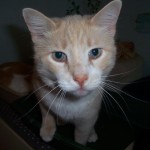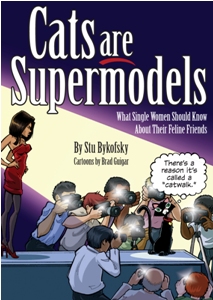By Patricia Fry
I’ve met, written about, and shared my home with some amazing cats over the years. This is the story of one such cat.
Have you ever noticed that the cat who is scheduled to go to the vet, to the groomer, or to be boarded, is nowhere to be found when it’s time to leave? Any other day, you can walk up to her and pet her or pick her up. But if you have a plan that involves a ride in the car, the cat darts under the bed. Right? Why? How do they know? Maybe this story will shed some light on the mystery.
It was not on Daisy’s agenda that hot summer day to see the groomer. She, no doubt, planned a day of lolling on the linoleum floor watching birds through the window. She didn’t know about her appointment with the groomer…or did she? She’d certainly made herself scarce all morning.
I’d lugged the heavy wire cat carrier from the garage and discreetly placed it just outside the back door. Rule number one: Don’t let the cat see the carrier or you’ll never get her near it. “Oh, there you are, girl. Come to Mama,” I crooned as I casually walked into the back bedroom where she lay curled up on a bed.
She looked up at me with sheer terror in her eyes and quickly disappeared under the bed. “How does she know?” I wondered. I probed the darkness with my hands where only dust bunnies and frightened cats go. But Daisy avoided capture.
When she thought the coast was clear, she crept out from under the far side of the bed and slunk down the hallway toward the kitchen. The gig was up—there was no place else where she could hide out of my range. This is going to be easy, I thought. But, in true feline style, the cagey cat outsmarted me again. Hugging her belly to the floor, she scurried into the living room. I knew better than to chase her, but I followed her just in time to see her silky tail disappear under a corner table. I scratched my head in disbelief. The little scamp had managed to position herself a scant few inches from my longest reach.
Obviously, this wasn’t working. And I knew full well that a cat that doesn’t want to be caught is usually a cat that won’t have to go to the groomer. Then I remembered something I’d read recently about using mind talk with animals. Could I communicate with Daisy through thoughts like J. Allen Boone had done with a dog and even ants and a gnat in his book, Kinship With All Life? Could I actually convince her to adopt my point of view? My options were few. What did I have to lose except, perhaps, a measure of dignity?
After bringing the wire carrier in, setting it in plain sight and opening the little door, I implemented my plan. I sprawled out on the floor and looked through the dimness under the table into Daisy’s large sea-green eyes. She stared back and I immediately began creating mind pictures. I visualized the plump calico standing up and walking toward the carrier, which sat empty a few feet away from me. I envisioned her stepping into the carrier then my closing the door and latching it behind her. I pictured the two of us going by car to the groomer where she would be lavished with attention. And then I created images of picking her up from the groomer and bringing her home flea-free, mat-free and just feeling wonderfully comfortable.
To my amazement, the moment I completed this mind-video, Daisy stood up, walked toward the carrier and, without hesitation, stepped inside. I lay there stunned as she moved to the back of the carrier and turned around until her tail was free of the little wooden door. Then she sat down and looked at me as if to say, “Well, close the door and let’s get on with it.”
Did I actually communicate through those mind pictures so Daisy understood? Did she choose to go to the groomer that day? Or was her compliance a fluke? I guess we’ll never know. But I can tell you that I’ve witnessed numerous incidents since that day to indicate that we can communicate with our cats. I’m sure you have, too. Now if we’d just learn to listen to what they have to say…
Patricia Fry is the author of the Klepto Cat Mystery series, cozy mysteries involving cats. The main cat character is Rags, an ordinary cat with some extraordinary habits. He can’t keep his paws off other people’s things and sometimes what he takes turns out to be a clue in the current mystery. Number 13 in the series is our first Christmas story—A Picture-Purrfect Christmas. It’s harrowing and it’s touching. Reviewers warn to have a box of tissues handy for the heart-warming ending. Available in print and for your Kindle here: http://www.amazon.com/Picture-Purrfect-Christmas-Klepto-Mystery-Book-ebook/dp/B016BBY2GY/ref=sr_1_1?s=books&ie=UTF8&qid=1448630793&sr=1-1&keywords=a+picture-purrfect+christmas
(For ages 18 to 118).




